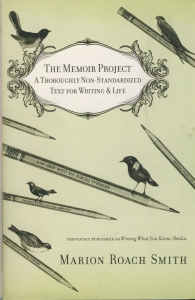Scenes & Credibility in Personal Narrative
It was a resplendent spring day. Light refracted into thousands of suns on the water. There was friendly conversation as students arrived at the seaside studio and settled in for our last session. We had just got started and the front door burst open.
A woman with a bundle under her arm, a feisty look, jet black hair and eyeliner strode in. She dropped her bundle on the table, which landed with the thump of a sandbag and said, “I’m here for the course” she said. “This is the most incredible story you will ever read. It has everything – Love, crime, death, murder, sex…
AND – it’s completely true. It all happened, I’ve got it right here” She patted the bundle. During break she pulled me aside and said,
“If you want to write it, I’ll give you 30%. It’s a guaranteed best seller.”
~~~
When budding writers have a big, dramatic story, they see bestseller. But penetrating the familiar is heavy work and poses some challenges.
Self-Referencing: Memoir or personal essay can veer into self-absorption with its I/me/my point of view. Frequent self-references slow the pace and distance the reader with intrusions of “I remember, I felt, I realized, I don’t remember, I will never forget…” More important than confirming your presence is the need to trust the material. Writers must back off emotionally, to better see and reveal all the differentiation and fine points of the scenes they describe. Self-referencing invites self reflection over concentrating on scenes.
Speaking of scenes: How does personal nonfiction narrative pull off factual scenes that illustrate and engage? They capture and describe the vivid moments, images, scenes and settings remembered. They use specific, concrete, particular details that appeal to the senses; the life blood of narrative.
Dialogue never takes the full role it has in fiction. Its overuse when recalling the distant past questions writer credibility. Early childhood memories spun out in remembered dialogue is always suspect. Use quotes from diaries, letters, and other correspondence. Add verity in context. Track facts on time, culture and place. Seek concrete and sensory detail to illustrate and resonate. And when you decide to bring in dialogue use a light hand, as does Beth Kephart in the scene below.
Scene Example in Memoir
In Still Love in Strange Places, Beth Kephart explores the ties that bind her to her El Salvadorian husband and his homeland. Here is a vivid scene that includes dialogue:
Our knees banged against each others knees. The pots, the pans, the Tupperware of onions, tomatoes, tortilla, fried chicken ricocheted about us freely. The jeep took the road like an amateur mogul skier, and down we flew, in only approximate parallel to the edge of the crusty cliff. “Look,” I shouted, over the din of the jeep, the deafening Spanish.
“Get her to slow down. I’m walking. Let me out.”
“Walking?” Bill shouted back, after my words had finally reached him. He was sitting right beside me, but there was a barrier of noise. “You’re not walking. Walking isn’t safe. Not here.”
“Isn’t safe?” I glared at him as if he alone had carved the roads and personally scrimped on their width. “Are you calling this safe?”
“Safer than walking. Especially for you, an American woman.”
… Then I caught another flash of all that height rushing by, another wave of nausea as the jeep skidded and shuddered and kept on hurtling. “I don’t even know where we’re going,” I shouted.
(From Still Love in Strange Places by Beth Kephart)
Kephart’s snippets of dialogue illuminate character, relationship, and situation but never steal the scene. The dialogue isn’t trying to “tell” what is going on, but adds authenticity, voice and characterization.
Focus: The difficult art of personal narrative requires a narrowed focus. The author works toward an insight or defining truth that lifts and distills, from the large context, a focusing force. Then memory becomes an organizing principal of this ‘event, that scene, this problem, that discovery’ and determines structure.
Distance: Focus requires distance. The author must pull back from the people and events to allow universal truths to emerge. Distance is also essential for unearthing theme.
Persona/Voice: When finding your narrating voice, isolating the story from the situation is a good place to start. Separate yourself from the myriad events. We all have many selves and each has a distinct voice – parent, child, executive, gardener, athlete, … In which self does the story reside? As Gornick says, “Experience is a large territory. How will the writer enter? From what angle? By what strategy? Toward what end?”
Tone, syntax and perspective play a role. So does your tenacity to run at the narrative until a strong, detached and generous narrator emerges to becomes an instrument of illumination.
Engagement: “The art of crafting a meaningful life becomes a process equal to the writing. What happened to the writer matters less than the large sense that he/she is able to make of what happened…. The reader must believe that the writer is on a voyage of discovery and that the narrator is reliable.” (Vivian Gornick-The Situation and the Story).
Focus, distance, persona, voice, engagement… and true stories well told. These elements of personal narrative writing allow the writer to engage with the material and bring perspective and wisdom to the story.
Annette Yourk, May 14, 2015

